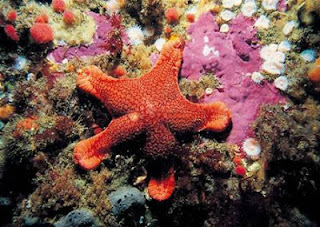1.
Which of the following systems is found in echinoderms?
a) Nervous system
b) Excretory system
c) Respiratory system
d) System of internal skeleton
2. The locomotory organs of
Echinoderms are called
a) Parapodia
b) Pseudopodia
c) Tube feet
d) Setae
3. The echinoderms are
related to chordates by their similarity in the development of
a) gut
b) nervous system
c) heart
d) coelom
4. Aristotle’s lantern is a characteristic feature of
a) starfishes
b) sea urchins
c) brittle stars
d) Holothurians
 |
| Aristotle’s lantern |
5. Auricularia is the larva of
a) Echinoidea
b)Asteriodea
c) Ophiuroidea
d) Holothuroidea
6. The terrestrial species
of Echinodermata is
a) Brittle star
b) Starfish
c) sea lilly
d) None of these
7. Which of the following is
a living fossil?
a) Holothuria (Sea cucmber)
b) Antedon (Feather star)
c) Ophiothrix (Brittle star)
d) Echinus (Sea urchin)
8. Which of the following is
not true of echinoderms?
a) Exclusively marine
habitat
b) Schizocoelic coelom
c) No excretory organs
d) Water vascular system
9. Bipinnaria larva is found in the development
of a
a) Sea-lily
b) Starfish
c) Sea cucumber
d) Sea star
10. Pedicellariae are
modified
a) tube feet
b) integumentary structures
c) Spines
d) some other structures
11. Starfishes are
a) herbiborous
b)Carnivorous
c) filter feeders
d) Omnivorous
12. The larva that occurs in
the development of sea urchin is
a) auricularia
b) echinopluteus
c) Bipinnaria
d) pluteus
13. Main difference between
starfishes and brittle stars is in the
a) number of arms
b) tube feet
c) structure of the
ambulacral groove
d) pedicellariae
14. Sausage shaped body form is a chacteristic of
a) Echinoidea
b) Asteriodea
c) Ophiuroidea
d) Holothuroidea
15. Madreporite is
associated with
a) Haemal system
b) Digestive system
c) Ambulacral system
d) Reproductive System
Learn more:
Answers:
1-d
|
2-c
|
3-d
|
4-b
|
5-d
|
6-d
|
7-b
|
8-b
|
9-b
|
10-c
|
11-b
|
12-b
|
13-c
|
14-d
|
15-a
|
Tags:
Antedon
Aristotle’s lantern
Auricularia
Bipinnaria larva.
Echinodermata
Madreporite
MCQ on Animal Kingdom
MCQ on Echinodermata
Pedicellariae

